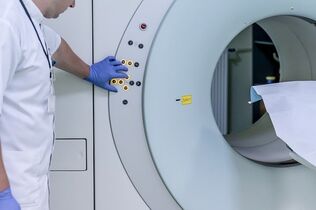Most people have back problems from time to time and experience pain in the lower back, neck or mid back. In fact, back pain is the most common physical ailment in the adult population and the leading cause of temporary disability. Back pain can be mild or severe, short-term or chronic.
Back pain includes: pain in muscles and tendons, slipped disc, fracture or other back problems. Most often, the reasons have a long history. Most often, back pain is caused by diseases of the spine.

The structure of the spine is designed for extreme loads. The structure of the spine is stable enough for a person to walk (stand) and flexible enough to perform trunk movements.
A healthy spine has an elongated S-shape when viewed from the side and features natural curves in the lumbar, thoracic and cervical spine. The spine is the main supporting part of the torso. In addition, the spine protects the spinal cord and spinal cord roots with its bone structure, thus ensuring normal innervation of organs and tissues.
Between each of the 24 vertebrae there are intervertebral discs that perform a cushioning function.
Reasons
Back pain refers to problems that a person creates primarily for himself. Back problems and back pain are most often caused by bad habits that have built up over a long period of time. These bad habits include:
- Bad posture
- Overvoltage during work
- Incorrect posture at desk or driving
- Repeated stretching or extension of the spine or abnormal and abrupt lifting of weights.
The results of habits rarely appear immediately, but more often their negative effects build up over time. One of the most common types of back pain is pain associated with tension in the muscles surrounding the spine. Most often, back pain associated with tension, muscles occur in the lumbar spine and cervical spine. If muscle tension is associated with lifting heavy objects, the pain can be excruciating.
Sometimes back pain occurs for no apparent reason. In these cases, they speak of non-specific back pain. Such pain can develop as a result of weakened muscles that cannot cope with everyday stress, such as walking, bending, and stretching. Additionally, such nonspecific pain can be triggered by poor sleep, general fatigue, or exposure to stressful situations.
Chronic pain in myofascial pain syndrome is caused by localized muscle tension. Sometimes this localized muscle tension is due to stress or other emotional problems.
Pregnancyis often the cause of the disease and this is due to both hormonal changes in the woman's body and weight gain and excessive stress on the spine and legs.
Injuries in contact sports, crashes, and falls can also cause back problems, ranging from minor muscle strains to severe injuries such as the spine and spinal cord.
It is important to understand that back pain is one of the symptoms of the disease and is not a diagnosis. Medical conditions that can cause back pain include the following:
Mechanical problems: Mechanical problems are related to the movement of the spine or the sensations a person experiences when performing certain movements. The most common mechanical cause is the degeneration of the intervertebral discs (osteochondrosis), when involutive changes occur in the intervertebral discs and deterioration of the cushioning functions of the discs, which leads to the appearance of pain. Another cause of back pain is degenerative changes in the joints of the spine (spondyloarthrosis). Other mechanical causes include muscle spasms, muscle tension, and a herniated disc.
Injuries: Spinal injuries such as sprains and fractures can cause both acute and chronic pain. Sprains, tears in the ligaments that support the spine, can occur due to twisting the torso or improper lifting. Fractures of the vertebrae are often the result of osteoporosis, a disorder in which bone density is reduced. Less commonly, back pain can be caused by more serious injuries that result from accidents and falls.
Acquired conditions and diseases. Many medical conditions can cause or contribute to pain. These include scoliosis, kyphosis, kyphoscoliosis, in which there is usually no pain until middle age. Various types of arthritis (osteoarthritis, rheumatoid arthritis, ankylosing spondylitis), stenosis of the spinal canal, affecting the nerve roots of the spinal cord. Diseases such as osteoporosis are inherently painless, but can lead to vertebral fractures, which manifest as severe pain. Other causes of back pain include pregnancy, kidney infections or urolithiasis, endometriosis, fibromyalgia, which is characterized by chronic fatigue and widespread muscle pain.
Infections and tumors. Although infections are not common causes of disease, infections can still cause pain. If the bone tissue is affected, then we are talking about osteomyelitis, if the infection affects the intervertebral discs, then we are talking about discitis. Tumors are also relatively rare in pain. Sometimes the tumors of the spine are primary, but most of the time the tumors are metastatic and the main target is in another part of the body.
Although the causes of back pain are generally physical, it is important to understand that emotional stress can play a role in both the intensity of the pain and its duration. Also, stress and emotional state can affect skeletal muscle tone. So, in the presence of depression and anxiety, back pain can be more intense. In addition, insomnia or lack of sleep can also contribute to or worsen the pain.
Back pain is only a symptom and can be reflected. Many diseases of the peritoneum and pelvic organs can cause spinal pain (appendicitis, aneurysm, kidney disease, bladder disease, infections and pelvic inflammatory diseases).
Risk Factors
- Age over 40
- Male gender
- Family history
- Previous wounds
- Pregnancy
- Spinal surgery in the past
- Congenital malformations of the spine.
- Lack of regular exercise
- Work or activity that requires prolonged weight lifting session.
- I smoke. People who smoke more often than people who don't smoke suffer from back pain.
- Overweight. Being overweight, especially those with fat around the waist, can strain your back and tend to have weak muscles and limited mobility
- Bad posture. Altered posture leads to a violation of the distribution of load vectors and muscle tension, muscle spasms and pain.
- Stress. Stress and other emotional factors are believed to play an important role in back pain, particularly chronic pain. Many people unknowingly strain their back muscles when they are under stress.
- Condition after a long period of depression.
- Long-term use of drugs (such as steroids) that weaken bone tissue.
- Lung diseases leading to chronic cough.
Symptoms
Most people have suffered from back pain during their life. There are many reasons for back pain, some of which a person creates for himself. Other causes include accidents, muscle sprains, sports injuries, and various diseases. Although the causes may be different, most often they are marked by the same symptoms.
- Persistent pain or stiffness in any part of the spine, from the base of the neck to the coccyx
- Acute, localized pain in the neck, upper back or lower back, especially after lifting heavy objects or doing strenuous activities. (Pain in the upper area can also be a sign of a heart attack or other life-threatening condition. )
- Chronic pain in the middle or lower part, especially after prolonged sitting or standing.
- Lower back pain that radiates to the buttocks of the leg.
- Inability to stand up.
But there are symptoms that warrant seeking medical attention
- A feeling of numbness, tingling or weakness in the arms or legs, as this could indicate a spinal cord injury.
- Lower back pain radiates to the leg, which may be a sign of root compression (radiculitis).
- The pain gets worse when you cough or lean forward, which can be a sign of a herniated disc.
- The pain is accompanied by fever and a burning sensation when urinating, which may be a sign of a urinary tract infection.
- Disturbances of bowel or bladder function
- History of cancer
- Weight Loss
- Long-term steroid use
- History of trauma
- Increased malaise even after rest.
- Pain lasting more than a month
- Night pain
- No treatment effect
- History of drug use
Diagnostics

Since the cause of back pain can be various conditions, therefore, first of all, careful collection of medical history and symptoms by the doctor is important. Both the localization of pain and the intensity, the presence of irradiation are important. The physical examination includes a careful examination of the neurological status (reflex activity, muscle strength, sensitivity, etc. ). If you suspect a disease of the pelvic organs, the doctor may prescribe a consultation with a gynecologist, a urologist.
Instrumental Research Methods
Radiography is generally of little value in diagnosing spinal pain, especially if there are no severe symptoms. The use of radiography is indicated for acute significant injury or minor injury in patients over the age of 50, patients with osteoporosis, or a long-term history of steroid use.
MRI is the most informative diagnostic method and allows for high-quality visualization of both bones and soft tissues and allows diagnosing both degenerative changes and tumors or infections.
For a clearer view of bone changes, CT may be recommended.
EMG and ENMG allow you to determine conduction along nerve fibers and muscles and, as a rule, are used in the diagnosis of chronic back pain.
Ultrasound examination of the abdominal organs or small pelvis, kidneys is necessary in case it is necessary to differentiate the source of pain.
Laboratory research methods are also used for the differential diagnosis of inflammatory diseases or infections.
Treatment
There are no universal treatments for back pain. Treatment of back pain in each individual case depends on both the genesis of pain manifestations and the individual characteristics of a person, since people's perception varies significantly.
Medical treatment includes the use of various drugs, either conventional pain relievers or NSAIDs, muscle relaxants or antibiotics for infections. With chronic pain syndrome, antidepressants, tranquilizers, or neuroleptics can be used.

Non-drug treatments such as physiotherapy, massage, manual therapy, acupuncture and physical therapy have been widely used in the treatment of back pain. These treatment methods are effective for acute and chronic pain manifestations associated with diseases of the spine.




































